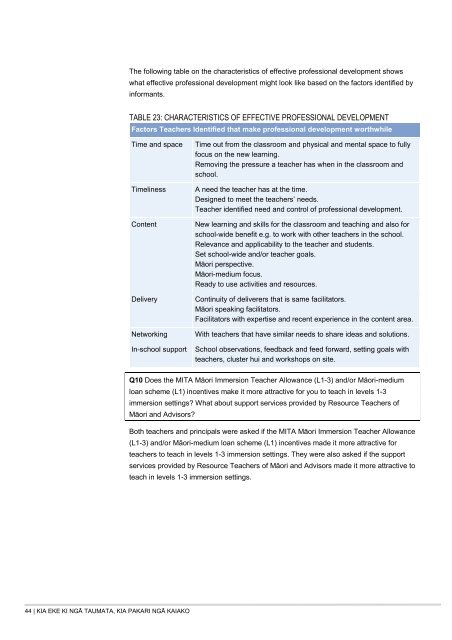Kia eke ki ngÄ Taumata, kia Pakari ngÄ Kaiako He ... - Te Puni Kokiri
Kia eke ki ngÄ Taumata, kia Pakari ngÄ Kaiako He ... - Te Puni Kokiri
Kia eke ki ngÄ Taumata, kia Pakari ngÄ Kaiako He ... - Te Puni Kokiri
Create successful ePaper yourself
Turn your PDF publications into a flip-book with our unique Google optimized e-Paper software.
The following table on the characteristics of effective professional development showswhat effective professional development might look like based on the factors identified byinformants.TABLE 23: CHARACTERISTICS OF EFFECTIVE PROFESSIONAL DEVELOPMENTFactors <strong>Te</strong>achers Identified that make professional development worthwhileTime and spaceTimelinessContentDeliveryNetwor<strong>ki</strong>ngIn-school supportTime out from the classroom and physical and mental space to fullyfocus on the new learning.Removing the pressure a teacher has when in the classroom andschool.A need the teacher has at the time.Designed to meet the teachers’ needs.<strong>Te</strong>acher identified need and control of professional development.New learning and s<strong>ki</strong>lls for the classroom and teaching and also forschool-wide benefit e.g. to work with other teachers in the school.Relevance and applicability to the teacher and students.Set school-wide and/or teacher goals.Māori perspective.Māori-medium focus.Ready to use activities and resources.Continuity of deliverers that is same facilitators.Māori spea<strong>ki</strong>ng facilitators.Facilitators with expertise and recent experience in the content area.With teachers that have similar needs to share ideas and solutions.School observations, feedback and feed forward, setting goals withteachers, cluster hui and workshops on site.Q10 Does the MITA Māori Immersion <strong>Te</strong>acher Allowance (L1-3) and/or Māori-mediumloan scheme (L1) incentives make it more attractive for you to teach in levels 1-3immersion settings? What about support services provided by Resource <strong>Te</strong>achers ofMāori and Advisors?Both teachers and principals were asked if the MITA Māori Immersion <strong>Te</strong>acher Allowance(L1-3) and/or Māori-medium loan scheme (L1) incentives made it more attractive forteachers to teach in levels 1-3 immersion settings. They were also asked if the supportservices provided by Resource <strong>Te</strong>achers of Māori and Advisors made it more attractive toteach in levels 1-3 immersion settings.44 | KIA EKE KI NGĀ TAUMATA, KIA PAKARI NGĀ KAIAKO
















